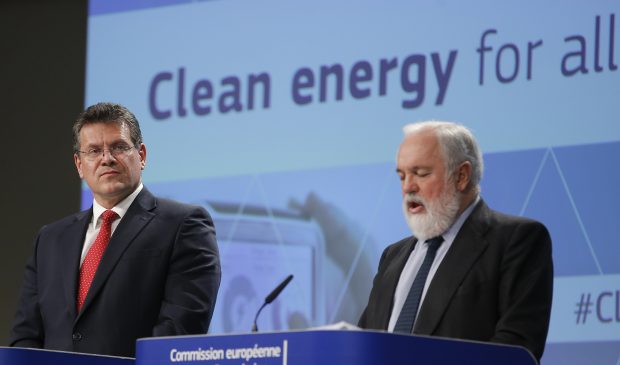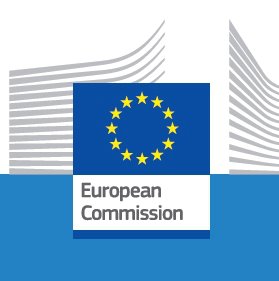European Commission Vice-President for Energy Union Maros Sefcovic and EU Commissioner in charge of climate and energy, Spanish, Miguel Arias Canete (R) give a press conference on Clean Energy package in Brussels, Belgium, 30 November 2016. EU has committed to cut CO2 emissions by at least 40 per cent by 2030. The Commission presents today a package of measures to keep the European Union competitive as the global clean energy transition is changing the energy markets. EPA/OLIVIER HOSLET
A 30% energy efficiency target, efficient buildings, clarified ecodesign framework and measures, smarter finance to help Europe grow while meeting its climate goals easer.
What happens today?
The globa lclean energy transition has started and it is irreversible. The European Union not only wants to adapt, but to lead. We want to achieve our ambitious climate and energy targets whilst maintaining a competitive economy in Europe that needs to provide the jobs and growth also for our future citizens.
To make sure that European consumers and businesses are fully equipped for this transition, the Commission is launching new and innovative energy efficiency measures. These measures focus on:
- Setting the framework for improving energy efficiency in general;
- Improving energy efficiency in buildings;
- Improving the energy performance of products (Ecodesign) and informing consumers (energy labelling);
- Financing for energy efficiency with the smart finance for smart buildings proposal.
As an encompassing element the Commission proposes a binding EU-wide target of 30% for energy efficiency by 2030, emphasising the EU’s commitment to put energy efficiency first.
Why is the Commission taking this action now?
The clean energy transition is key for the current European strategy for jobs and growth, the number onepriority of the Juncker Commission. The clean energy transition is where the smart money is: last year, clean energy attracted a record global investment of over 300 billion euros, six times the amount in 2004. With our new measures Europe will also be a frontrunner in implementing the UN Sustainable Development Goals (SDG), including SDG 7 on affordable, reliable, sustainable and modern energy for all.
The review of the energy efficiency legislation unlocks the energy savings that can boost growth in the EU’s economy, investments and job creation. Our proposal for an EU level binding target of at least 30% by 2030 will reduce the EU’sfossil fuel import bill. It will translate to jobs and higher gross domestic product.
What concrete benefits does energy efficiency bring?
When implemented by Member States, some proposed measures will have immediate and tangible effects. Ambitious energy efficiency targets for 2030 can reduce a Member State’s dependence on energy imports, boost the local economy, increase its competitiveness and create additional green jobs.
In the case of building renovation itshould result in creating the right market conditions for increasing the rate and level at which buildings are renovated. It will also ensure a stable framework with a long-term perspective and vision towards the decarbonisation of buildings, which will lead to the transformation of the EU building stock while creating growth and jobs.
Ecodesign measures ensure that only energy efficient appliances can be sold on the EU market. The EU energy labelling system ensures that consumers can make informed choices when buying energy appliances. Overall, consumers using only energy efficient products in their homes could be saving an average of €500 annually per household by 2020.
In addition, energy efficiency obligations schemes allow reducing the energy bills for consumers as a result of lower energy demand due to actions taken to replace inefficient windows or insulate walls. Studies show that utility schemes can reduce energy bills for consumers by up to 20%, and it comes with a wide range of benefits such as higher comfort level and more disposable income.
What will change for energy efficiency policy?
With today’s proposals, the Commission proposes to update the existing Energy Efficiency Directive by:
- aligning energy efficiency targets with the EU 2030 climate and energy framework;
- extending beyond 2020 the energy saving obligation requiring energy suppliers and distributors to save 1.5% of energy each year from 2021 to 2030 with a view to attracting private investment and supporting the emergence of new market actors; to enable tailor-made policies that take account of national specificities, Member States can also meet this requirement through alternative measures having the same effect, such as energy efficiency support schemes;
- improving metering and billing of energy consumption for heating and cooling consumers.
Furthermore, the Commission is proposing changes to the Energy Performance of Buildings Directive, which is set to be:
- Smart, by encouraging the use of ICT and modern technologies, including building automation and charging infrastructure for electric vehicles, to ensure buildings operate efficiently;
- Simple, by streamlining or deleting provisions that have not delivered the expected output;
- Supportive of building renovation, by strengthening the links between achieving higher renovation rates, funding and energy performance certificates as well as by reinforcing provisions on national long-term building renovation strategies, with a view to decarbonising the building stock by mid-century.
In addition, the Commission is launching a smart finance for smart buildings initiative to unlock private financing for energy efficiency and renewables in buildings at a greater scale.
What are the impacts on climate?
Keeping the momentum in energy efficiency will bring multiple benefits for the climate. With the new Energy Efficiency Directive:
- the Commission sets a EU binding 30% target for energy efficiency, which will bring significant contribution to reductions in global greenhouse gas emissions.
- all Member States will have to contribute to the achievement of the binding EU target as part of the Integrated National Energy and Climate Plans under the Governance Regulation.
What is energy efficiency doing for the construction sector?
Buildings accounts for 40% of Europe’s energy consumption. Two-thirds of EU’s buildings were built before energy performance standards existed, and their renovation rate is only around 1% per year.
The changes proposed by the Commission in the Energy Efficiency Directive and the Energy Performance of Buildings Directive aim to speed up the renovation rate of existing buildings with a view to decarbonising the building stock by mid-century. This will have direct impacts on consumers and households alike – through lower energy bills. And, it will contribute significantly to the competitiveness of European industry by creating a building renovation market for SMEs with a value of €80-120 billion in 2030.
What further actions are proposed for the construction sector?
The European construction industry alone provides 18 million direct jobs in Europe and creates 9% of GDP. It has the potential to respond to a number of economic and societal challenges, like jobs, growth and the need for increased use of clean energies. On top of the legislative proposals, the Commission is also proposing a set of facilitating measures to support, already before the legislation enters into force, the objectives of the Energy Union and the modernisation of the construction sector and its workforce. The measures focus on the digitalisation of buildings’ characteristics, tackling skills shortages in the construction section, including energy efficiency and digital skills, ensuring better coherence of the internal market functioning and supporting new initiatives to improve the environmental performance of buildings in line with the circular economy.
Will energy efficiency affect the products we buy?
Ecodesign and Energy Labelling improve the energy and resource efficiency of products and reduce emissions, waste and energy dependency.
By 2020, the Ecodesign policy is expected to deliver yearly energy savings equivalent to the annual energy consumption of Italy. As a result, European households can save up to €500 per year on their energy bills. Moreover, this policy is estimated to deliver approximately €55 billion per year extra revenue for industry, wholesale and retail sectors, which supports jobs and growth in our economy.
In addition to this, the measures announced in the Ecodesign working plan for 2016-2019 have the potential to deliver further energy savings by 2030, which are equivalent to the annual energy consumption of Sweden and deliver commensurate benefits for consumers, businesses and the environment.
Last but not least, the new Ecodesign working plan contributes to a more circular economy by introducing more systematic focus on elements such as durability, reparability and recyclability in developing new Ecodesign measures and in-depth assessment of ICT products such as mobile/smart phones will be launched to explore their circular economy potential.
Why a new approach to Ecodesign?
Given the success already achieved in reducing our energy consumption, the Commission now wants to move to the next phase and select additional products to maximise the impact in terms of energy saving.
First, the Commission analysed very carefully which products would yield the biggest results in terms of energy saving. In the Ecodesign Working Plan, the focus is on products with the most savings potential. The new Ecodesign Working Plan for the 2016-2019 period includes a list of new product groups and how Ecodesign will contribute to circular economy objectives.
Second, the Commission also took a fresh look at previous work plans and confirmed the importance of the reviews of existing Ecodesign standards to keep up with technological progress.
Besides the Ecodesign Working plan to launch new work, the Commission today adopted a number of concrete measures that ensure the continuation of this successful policy, in particular:
- guidelines for voluntary agreements to facilitate industry pursuing self-regulation as an alternative to legislation in some cases;
- measures on verification tolerances to improve product testing and compliance checking by Member States and to reduce the scope for cheating;
- new Ecodesign requirements for air heating and cooling products to deliver substantial energy savings.
How are we mobilising investments?
As part of the Investment Plan for Europe, the European Fund for Strategic Investments (EFSI) presents a major opportunity to mobilise financing for energy efficiency projects. The vast majority of energy projects approved for financing concerns energy efficiency and the renewable energy sector. In 2014-2020, the European Regional Development Fund and the Cohesion Funds will also invest about €17 billion in energy efficiency in public and residential buildings and in enterprises, with a focus on SMEs – three times the amount than in 2007-2013.
As the need to mobilise and unlock private investment is key for a successful energy efficiency policy, the Commission is launching the Smart Finance for Smart Buildings initiative. This initiative can unlock an additional € 10 billion of public and private funds until 2020 by:
- encouraging more effective use of public funds including through the development of flexible energy efficiency and renewable financing platforms to boost the combination of the European Fund for Strategic Investment and other public funds, including European Structural Investment Funds;
- helping project developers bring good project ideas to maturity with more project development assistance and aggregation mechanisms;
- making energy efficiency investments more trusted and attractive for project promoters, financiers and investors.
What are the benefits for…
…consumers?
Energy efficiency has a direct impact on lowering the energy bill. Changes on metering and billing for heating and cooling, and hot water supplied from collective systems, will give consumers clearer and more frequent information on the energy consumed. In multi-apartment buildings alone this could trigger additional energy savings of some 8 Mtoe in 2030, which equals Croatia’s primary energy consumption in 2013.
Energy efficiency also addresses social imbalances in energy access: the performance of buildings has a major impact on affordability of housing and on energy poverty. The efficiency improvement of the housing stock would enable many households to escape energy poverty. The proposal could contribute to take out from energy poverty between 515,000 to 3.2 million households in the EU (from a total of 23.3 million households living in energy poverty).
Energy efficiency also has a positive impact on health, and the related costs: modern and efficient heating installations burn less fossil fuel and emit fewer air pollutants, thus improving air quality and reducing greenhouse gas emissions. Adequately heated and ventilated dwellings alleviate negative health impacts caused by dampness, particularly amongst vulnerable groups such as children and the elderly and those with pre-existing illnesses.
… industry?
Energy efficiency is a vast and growing business opportunity that European businesses are particularly well placed to exploit: it is a sector with a huge untapped potential, and an area in which EU businesses have major strongholds and innovative solutions to offer. According to Commission studies, the existing ecodesign framework could add an extra €55 billion in yearly revenues for European businesses by 2020.
The revised Energy Efficiency Directive and the revised European Performance of Buildings Directive will significantly contribute to the competitiveness of European industry (mainly insulation and flat glass) by increasing their market by €23.8 billion in the EU by 2030, and creating a building renovation market for SMEs with a value of between €80-120 billion. Additional energy efficiency work (roof insulation, window replacement, building system upgrade, etc.) in the construction sector is estimated at approximately €47.6 billion.
Greater energy efficiency will help European companies improve their competitiveness by keeping their costs down.
…jobs?
Overall, the whole 2030 energy and climate package could boost the EU’s GDP by up to 1% by 2030, pumping an additional €190 billion into the EU’s economy and creating up to 900,000 new jobs. The 30% energy efficiency target alone can create benefits in the real economy up to an additional €70 billion euros and 400,000 jobs compared to a 27% target.
Evidence shows that:
- investing in energy efficiency compares favourably with investing in other energy sectors in terms of local jobs creation;
- employment creation from investing in energy efficiency may be between 2.5 and 4 times larger than from investing in oil and natural gas;
- for every €1 million spent on energy efficiency about 20 jobs are directly supported in the energy efficiency industry.
… energy security?
Energy efficiency is also one of the most cost-effective ways to ensure energy security. It has strong beneficial impacts on security of supply and the level of gas imports, in particular. Compared to 27% target, an ambitious 30% energy efficiency target will improves energy security by reducing fossil fuel imports by 12% in 2030 which correspondents to import saving of 70 billion euros.
The buildings sector alone will contribute to the overall savings by 2030 with 29.1 Mtoe, which is equivalent to the total primary energy consumption of Romania in 2014.
How does energy efficiency fit the whole of energy transition?
Energy efficiency contributes to the reduction of greenhouse gases and goes hand in hand with renewable energies to enable the energy transition. It is also an integral part of the Energy Union Governance – whichframes the member states’ contributions to the binding EU-level efficiency target as part of their Integrated National Energy and Climate Plans.
The Governance Regulation sets up a reliable mechanism under which Member States report on progress made and the Commission assesses collective progress towards the 2030 efficiency target. In case the ambition of national plans or their delivery (i.e. progress made) is insufficient, the Commission can take measures at EU level in order to ensure the achievement of the target. Such measures may in particular aim at improving the energy efficiency of products, buildings and transport. The close coordination with the Governance Regulation also ensures that the existing planning, reporting and monitoring obligations for energy efficiency post 2020 are streamlined and integrated.
What does the Commission do to tackle energy poverty?
Energy poverty is a major challenge across the EU, having its roots in low incomes and energy inefficient housing. In 2014, the lowest-income households in the EU spent close to 9% of their total expenditure on energy.
This package sets out a new approach to protecting vulnerable consumers, including by supporting energy efficiency investments. The Commission’s energy efficiency proposals ask Member States to take energy poverty into account, by requiring a share of energy efficiency measures to be implemented as a priority in households affected by energy poverty or in social housing. Their long-term building renovation strategies should also contribute to the alleviation of energy poverty.
Also, as part of the Energy Union Governance process, Member States will have to monitor and report on energy poverty while the Commission will facilitate the exchange of best practices. Moreover, in line with its efforts to empower and protect consumers, the Commission proposes certain procedural safeguards before a consumer can be disconnected. The Commission is also setting up an Energy Poverty Observatory to provide better data on the problem and its solutions as well as to help Member States in their efforts to combat energy poverty.
Brussels, 30 November 2016
Originally published by European Commission







Be the first to comment on "Putting energy efficiency first: consuming better, getting cleaner"